Ingrown horns continue to draw substantial penalties
Two recent prosecutions have once again highlighted the need for livestock producers to closely and regularly inspect their animals to ensure that they can identify any welfare issues, and treat them accordingly.
In February, an offender was fined $14,000 and ordered to pay courts costs of $753.30 in a case relating to eight cows with either one or both horns ingrown, causing significant wounds. These cattle were part of a consignment of 67 that were sent to an abattoir in the state’s South West.
Some of the wounds were described as being inflamed and weeping, and attracting flies. In some cases, the horns had penetrated to a depth of almost 5cm and were assessed as being weeks or even months old.
In a separate incident, a man was fined $3,000 in Kalgoorlie Magistrates Court in February in a case relating to bull with an ingrown horn.
In January 2017, an inspector in the department’s Livestock Compliance Unit identified the injured bull during an inspection at the Muchea Livestock Centre. The bull had been transported from a pastoral property in the Goldfields. The ingrown horn had penetrated the skull by 9cm on one side and the wound was infected.
The offenders in both cases were convicted of failing to take reasonable steps to alleviate harm to an animal.
Department principal compliance inspector Charlotte McIntyre said it was reasonable to expect that ingrown horns such as these should have been identified and treated.

